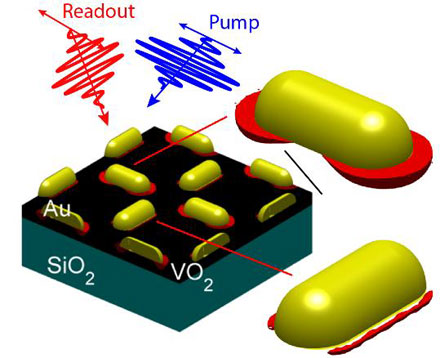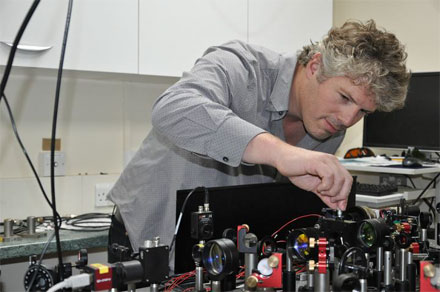Fast optical switches developed using nanoantenna-assisted phase transition could open novel routes to the next generation of optoelectronics.
The properties of nanoantennas were tuned to achieve low energy optical switching of a phase-change material, vanadium dioxide (VO2). Gold nanoantennas were fabricated on top of this thin film and were used to locally drive the phase transition of the VO2.
The picosecond all-optical switching of the local phase transition in plasmonic antenna VO2 hybrids was shown by exploiting strong resonant field enhancement and selective optical pumping in plasmonic hotspots. Polarization- and wavelength-dependent pump–probe spectroscopy of multifrequency crossed antenna arrays revealed that nanoscale optical switching in plasmonic hot spots did not affect neighboring antennas placed within 100 nm of the excited antennas. The antenna-assisted pumping mechanism was confirmed by numerical model calculations of the resonant, antenna-mediated local heating on a picosecond time scale.

An artists' impression of gold antennas on vanadium dioxide thin-film, with antenna-assisted phase transition (red). Courtesy of University of Southampton.
The hybrid, nanoscale excitation mechanism resulted in 20 times reduced
switching energies and five times faster recovery times than a VO2
film without antennas, enabling fully reversible switching at over 2
million cycles per second and at local switching energies in the
picojoule range. Results of the work show that the hybrid solution of
antennas and VO2 provides a conceptual framework to merge the
field localization and phase-transition response to enable precise,
nanoscale optical memory functionality.
The research was conducted by a team of scientists led by the University of Southampton.
Professor Otto Muskens said, "The nanoantenna assists the phase transition of the vanadium dioxide by locally concentrating energy near the tips of the antenna. It is like a lightning-rod effect. These positions are also where the antenna resonances are the most sensitive to local perturbations. Antenna-assisted switching thus results (in) a large effect while requiring only a small amount of energy."

With the miniaturization of optical components and the convergence of electronic and photonic technologies, ultracompact devices are needed to control and switch light on length scales comparable to the optical wavelength. Resonant plasmonic antennas at visible and NIR wavelengths offer the capability to concentrate energy in space and time and enhance light–matter interaction and nonlinear response. Hybrid devices combining plasmonic antennas with materials showing a structural or electronic phase transition provide unique opportunities because they can provide very large changes in optical response. Excitation of this phase-change response using the optical near-field opens up routes for achieving ultrasmall switching volumes and low-energy devices.

Professor Otto Muskens. Courtesy of University of Southampton.
“If we are able to actively tune a nanoantenna using an electrical or
optical signal, we could achieve transistor-type switches for light with
nanometer-scale footprint for data communication. Such active devices
could also be used to tune the antenna's light-concentration effects
leading to new applications in switchable and tunable antenna-assisted
processes," said Muskens.
Fabrication of the VO2 was done by a team at the University of Salford who specialize in thin-film deposition. The theoretical modeling was done by a team from the University of the Basque Country. Their calculations revealed that the nanoantennas provided a novel pathway by local absorption around the antenna.
The antenna-assisted mechanism resulted in a much lower switching energy compared to just the VO2 film, corresponding to picojoule energies and a calculated efficiency of over 40 percent.
The research was published in Light: Science & Applications (doi:10.1038/lsa.2016.173).